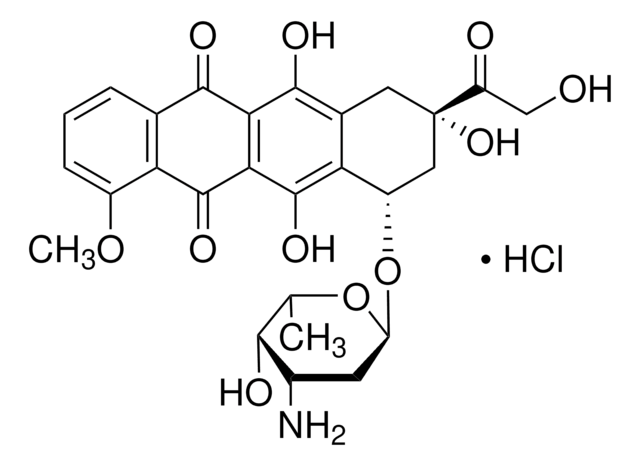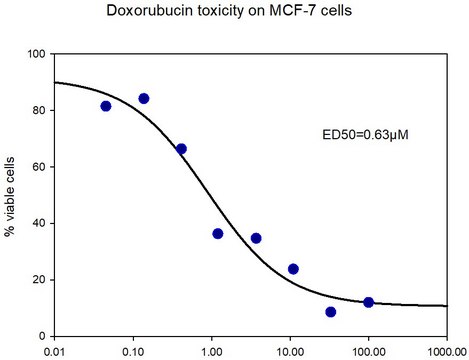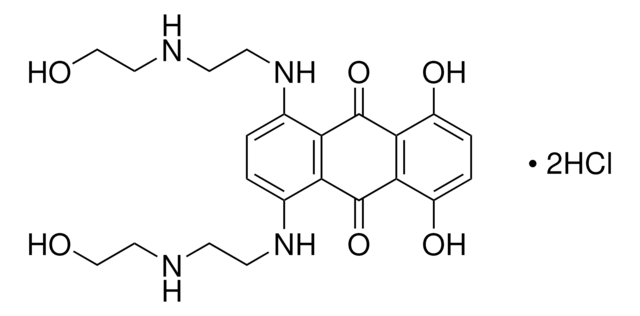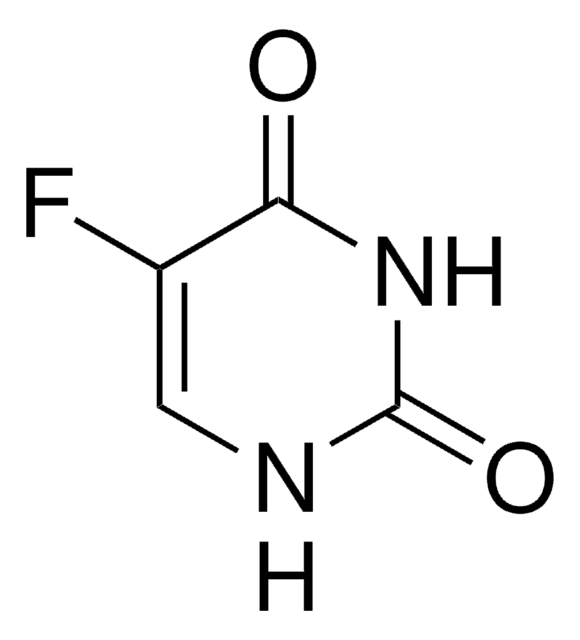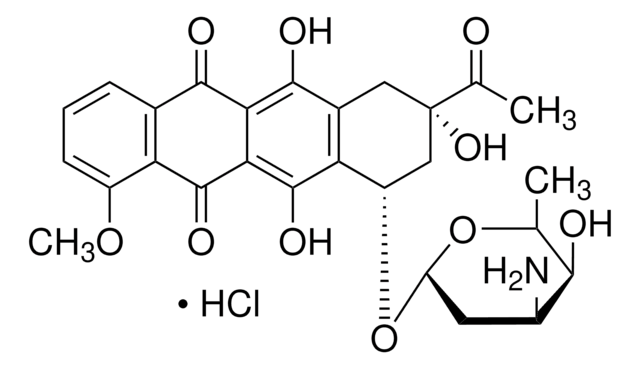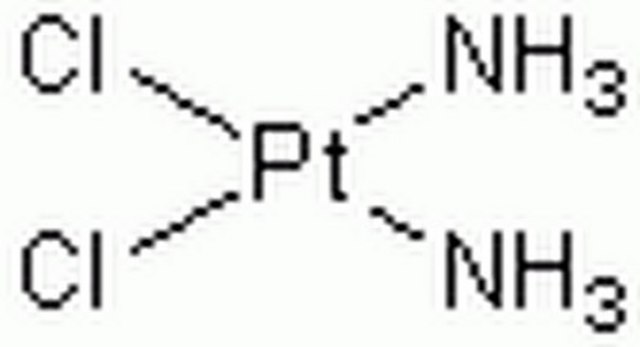44583
Doxorubicin hydrochloride
suitable for fluorescence, 98.0-102.0% (HPLC)
Synonym(s):
DOX, Hydroxydaunorubicin hydrochloride
About This Item
Recommended Products
biological source
synthetic
Quality Level
Assay
98.0-102.0% (HPLC)
form
solid
color
orange to dark red
mp
216 °C (dec.) (lit.)
solubility
H2O: 50 mg/mL, clear, orange to red
DMSO: soluble
THF: soluble
ethanol: soluble
methanol: soluble
fluorescence
λem 580-590 nm
suitability
suitable for fluorescence
antibiotic activity spectrum
neoplastics
Mode of action
DNA synthesis | interferes
enzyme | inhibits
storage temp.
2-8°C
SMILES string
Cl[H].COc1cccc2C(=O)c3c(O)c4C[C@](O)(C[C@H](O[C@H]5C[C@H](N)[C@H](O)[C@H](C)O5)c4c(O)c3C(=O)c12)C(=O)CO
InChI
1S/C27H29NO11.ClH/c1-10-22(31)13(28)6-17(38-10)39-15-8-27(36,16(30)9-29)7-12-19(15)26(35)21-20(24(12)33)23(32)11-4-3-5-14(37-2)18(11)25(21)34;/h3-5,10,13,15,17,22,29,31,33,35-36H,6-9,28H2,1-2H3;1H/t10-,13-,15-,17-,22+,27-;/m0./s1
InChI key
MWWSFMDVAYGXBV-RUELKSSGSA-N
Gene Information
human ... TOP2A(7153)
Looking for similar products? Visit Product Comparison Guide
General description
Application
Biochem/physiol Actions
Packaging
Other Notes
Signal Word
Danger
Hazard Statements
Precautionary Statements
Hazard Classifications
Acute Tox. 4 Oral - Carc. 1B - Muta. 1B - Repr. 1B
Storage Class Code
6.1C - Combustible acute toxic Cat.3 / toxic compounds or compounds which causing chronic effects
WGK
WGK 3
Flash Point(F)
Not applicable
Flash Point(C)
Not applicable
Personal Protective Equipment
Regulatory Information
Choose from one of the most recent versions:
Certificates of Analysis (COA)
Don't see the Right Version?
If you require a particular version, you can look up a specific certificate by the Lot or Batch number.
Already Own This Product?
Find documentation for the products that you have recently purchased in the Document Library.
Which document(s) contains shelf-life or expiration date information for a given product?
If available for a given product, the recommended re-test date or the expiration date can be found on the Certificate of Analysis.
How do I get lot-specific information or a Certificate of Analysis?
The lot specific COA document can be found by entering the lot number above under the "Documents" section.
How do I find price and availability?
There are several ways to find pricing and availability for our products. Once you log onto our website, you will find the price and availability displayed on the product detail page. You can contact any of our Customer Sales and Service offices to receive a quote. USA customers: 1-800-325-3010 or view local office numbers.
What is the Department of Transportation shipping information for this product?
Transportation information can be found in Section 14 of the product's (M)SDS.To access the shipping information for this material, use the link on the product detail page for the product.
What is the function of Doxorubicin hydrochloride, Product 44583?
In chemotherapy: "Doxorubicin HCl is the hydrochloride salt of doxorubicin, an anthracycline antibiotic with antineoplastic activity. Doxorubicin, isolated from the bacterium Streptomyces peucetius var. caesius, is the hydroxylated congener of daunorubicin." -National Cancer Institute.
At what concentration can Doxorubicin hydrochloride, Product 44583, be dissolved in water? At what concentration in DMSO?
The solubility of Product No. 44583 tested in water (50 mg/mL), yielding a clear orange to red solution. It is also soluble in DMSO (50 mg/mL), ethanol, methanol and tetrahydrofuran.
How stable is a solution of Doxorubicin hydrochloride, Product 44583?
According to the 11th edition of the chemicals encyclopedia published by the Royal Society of Chemistry, "aqueous solutions are unchanged after one month at 5 °C but unstable at higher temperatures or at either acid or alkaline pH. Several studies cite that stability is related to pH, exposure to light and the medium used for storage. Doxorubicin hydrochloride is subject to light degradation at <0.5 mg/mL, with considerable loss of bioactivity. If stored at 25 °C in the dark in 5% glucose, pH 4.7 (or 3.3% glucose + 0.3% sodium chloride, pH 4.4), solutions were stable (5% or less change) for at least 4 weeks".
How should I use Product D1515 - Doxorubicin hydrochloride to induce double strand breaks in the DNA of HeLa cells?
We do not test Product D1515 - Doxorubicin hydrochloride for biological activity with HELA cells. The following paper used 100 nM to 250 nM doxorubicin Adam Hermawan, et al., Journal of Natural Remedies, Vol. 12/2 (2012) 108-114The following paper uses 0.01 to 1.0 mug/ml doxorubicin SH Kim, et al., CANCER RESEARCH 32, 323-325, February 1972
My question is not addressed here, how can I contact Technical Service for assistance?
Ask a Scientist here.
Articles
Explore how antibiotics, particularly quinolones, inhibit nucleic acid synthesis by targeting topoisomerases, crucial for DNA replication processes.
Graphene oxide, a monomolecular layer of graphite with oxygen functionalities, holds unique properties valuable for various applications in materials science.
Our team of scientists has experience in all areas of research including Life Science, Material Science, Chemical Synthesis, Chromatography, Analytical and many others.
Contact Technical Service